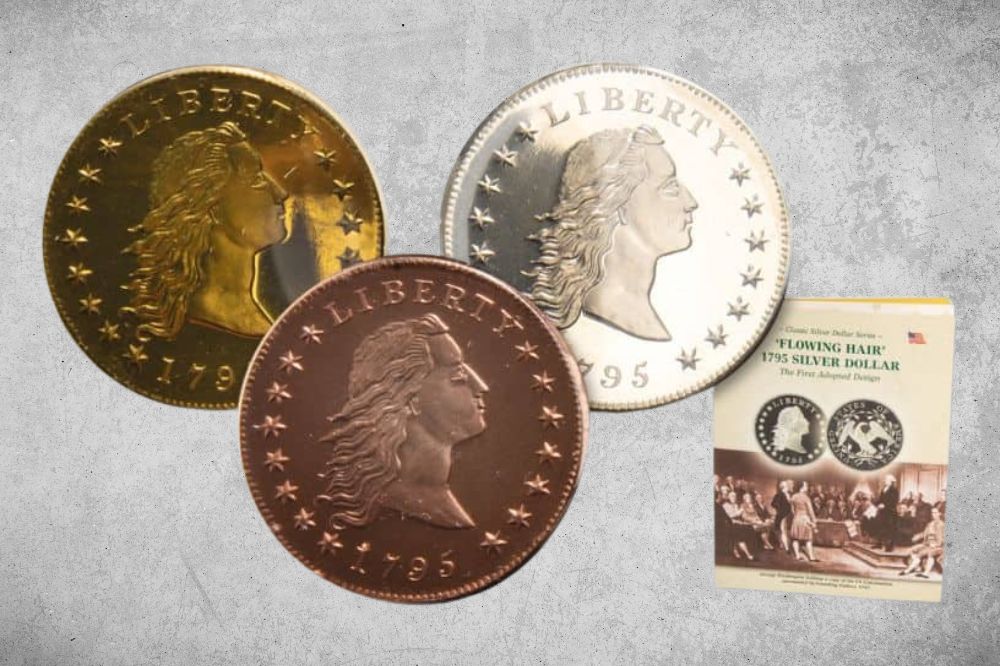The first US $1 silver coins were made between the autumn of 1794 and the autumn of 1795. While this technically makes 1794 the birth year of the first US silver dollar, 1795 is often cited instead as it saw both the much larger mintage as well as the transition from the initial 1794 “Flowing Hair” dollar design into the “Draped Bust” coin that went on to be mass produced later.
The “Flowing Hair” 1795 Silver Dollar Details
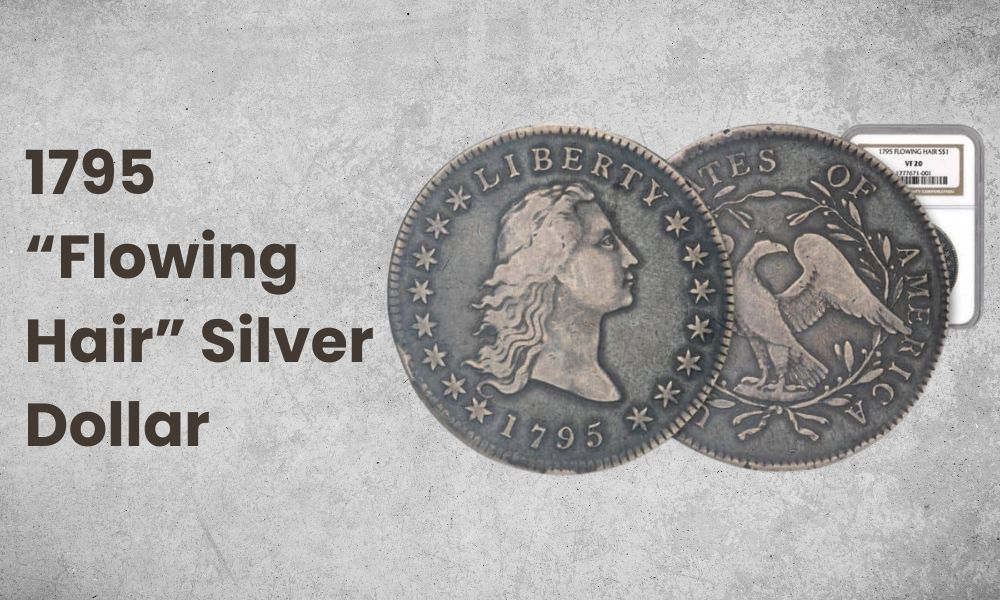
- Category: Early Dollars (1794-1804)
- Mint: Philadelphia
- Mintage: ~160,295
- Obverse and Reverse designer: Robert Scott
- Lettering: Frederick Geiger
- Composition: 90% silver / 10% copper
- Diameter: 39-40 mm
- Edge: Lettered
- ASW: 0.7731 oz
- Weight: 26.96 g / 416 grains
The 1794 and 1795 Flowing Hair silver dollar was commissioned by the US Congress in 1791 and was officially authorized by the Coinage Act of 1792. It took a few years for the coin to be designed, the printing process to be prepared, and the necessary materials to be amassed.
The size and weight of this first US silver dollar were intentionally made similar to those of the Spanish peso as those were common in the US at the time. The design was that of Lady Liberty but without her signature Phrygian cap and with her hair flowing instead, hence the name of the coin.
Also Read: Top 21 Most Valuable 2000 P Sacagawea Dollar Coin Worth Money
The “Draped Bust” 1795 Silver Dollar Details
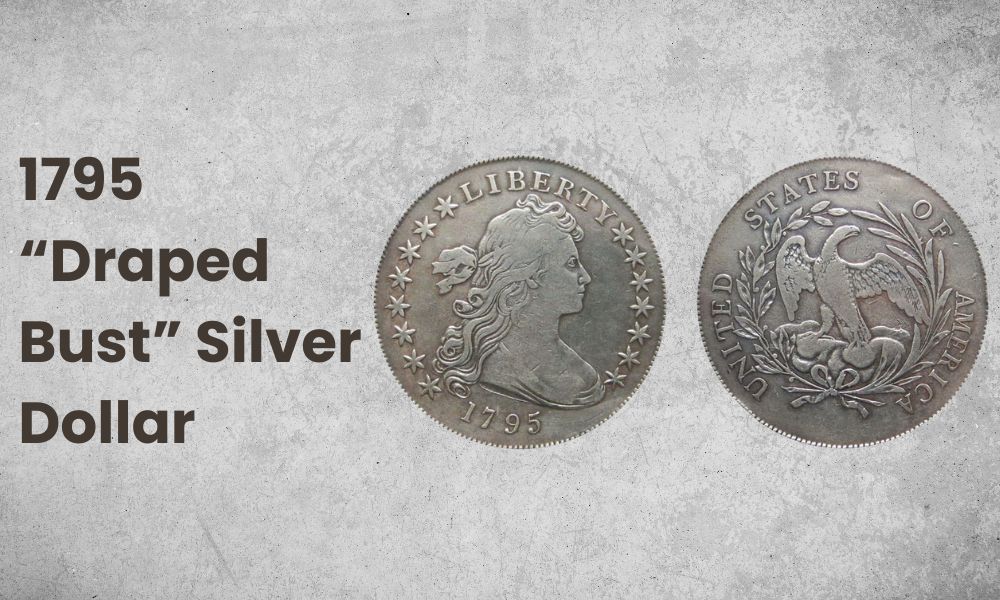
- Category: Early Dollars (1794-1804)
- Mint: Philadelphia
- Mintage: ~42,738
- Obverse Designer: Gilbert Stuart
- Reverse Designer: Gilbert Stuart
- Composition: 89.2% silver / 10.8% copper
- Diameter: 39-40 mm
- Edge: Lettered
- ASW: 0.7731 oz
- Weight: 26.96 g / 416 grains
The Draped Bust (re-)design of the US silver dollar was commissioned soon after the Flowing Hair dollar started getting distributed. The reasons were several, mostly political and economic. For example, the 90%/10% composition of the Flowing Hair silver dollar meant that the production price was higher than the expected 89.2%/10.8% standard.
Another issue was that the design of the Flowing Hair dollar wasn’t as widely liked as people had hoped. In fact, it had sturred a lot of public ire. This is generally to be expected with anything new but it is somewhat comical that the design of the (much more liked at the time) Draped Bust dollar is fairly similar to that of the Flowing Hair dollar, except with a deeper neckline.
1795 Silver Dollar Value Chart |
||||
| Silver Dollar Version | 1 – 50 | 50 – 60 | 61 – 63 | 64 – 70 |
| Flowing Hair Dollar | $2,100 – $15,000 | $20,000 – $60,000 | $67,500 – $150,000 | $290,000 – $1,080,000+ |
| Draped Bust Dollar | $1,850 – $9,000 | $15,500 – $51,000 | $62,500 – $130,000 | $180,000 – $850,000+ |
1795 Silver Dollar Value and Varieties Guides
As the Flowing Hair and Draped Bust silver dollars are the first silver dollars to ever be produced in the United States, there aren’t that many variations of them, especially not from 1794 and 1795.
Draped Bust dollars from later years have been made with some differences, however. For example, the original Draped Bust featured the so-called “small eagle” on the reverse side of the coin whereas Draped Bust silver dollars produced after 1798 had a different eagle design.
Here, we are talking about the 1795 silver dollars, in particular, however, so the “Small Eagle Draped Bust” is the only variation of this coin from that year.
The Flowing Hair 1795 silver dollar was made in two variations before its production was discontinued, however – the “2 Leaves” and the “3 Leaves” Flowing Hair silver dollar.
1795 Flowing Hair Silver Dollar 2 Leaves
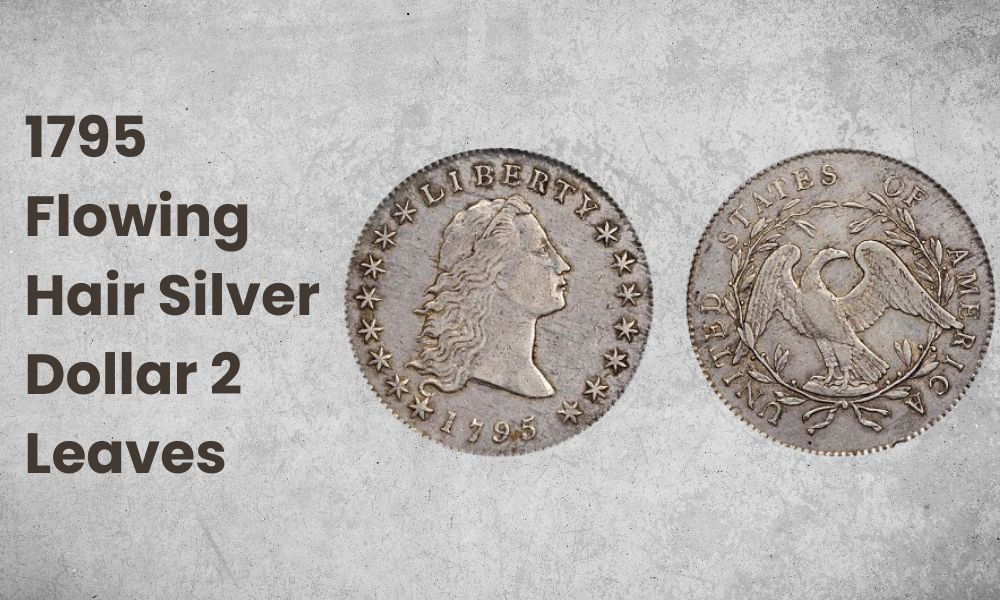
The first variant of the Flowing Hair silver dollar is the “2 Leaves” one. As the name implies, this dollar is characterized by the fact that there are only two leaves on either side of the branch the eagle is perched on.
1795 Flowing Hair Silver Dollar 3 Leaves
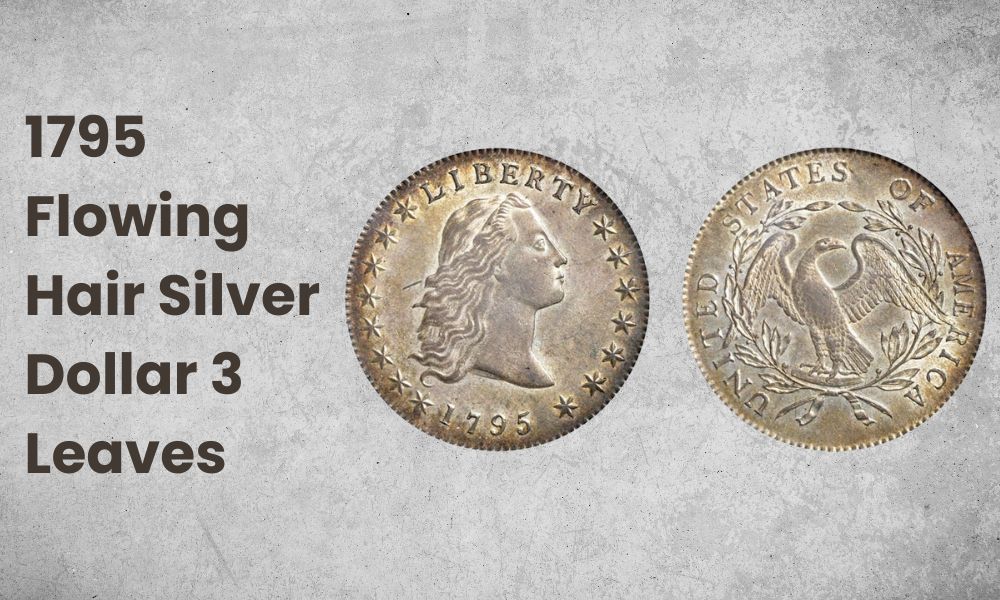
The other variant of the 1705 Silver dollar is that the branch under the eagle’s feet has 3 leaves on either side rather than just two. Its design is otherwise unchanged from that of the 2 Leaves Flowing Hair silver dollar and no other variants were produced by the time the Draped Bust went into printing by late 1975.
Also Read: Top 19 Most Valuable Morgan Dollars Worth Money
1795 Silver Dollar Grading
Using the standard 1 to 70 Sheldon grading scale that’s widely accepted, we can see that both types of 1795 silver dollars are incredibly valuable. Even the lowest quality grades – coins in such bad condition that they are only barely recognizable – come with price tags in the 4- and 5-digit range.
And the better quality coins, especially past the 62nd and 63rd grade, can easily score prices over $100,000, going up to a million $ or more for the finest quality coins.
Of course, given that the 1795 silver dollar is over two centuries old, such perfect quality is exceedingly rare. But the beauty of old and rare coins like these is exactly that they are always valuable, even if their quality isn’t top-notch. To give you an idea of how rare and highly appreciated 1795 silver dollars are when they are of great quality, check out this video.
1795 Silver Dollar History
The 1794-1795 silver dollar is the first dollar coin issued by the US government. It isn’t the first official US currency, however – that honor belongs to the 1787 Franklin cent, also known as the Fugio cent. It was made of 10 grams of copper (0.36 oz) and it’s rumored to have been designed by Benjamin Franklin himself.
After the Fugio cent came into circulation, the US Congress issued the production of a silver dollar in 1791 after a study conducted by Alexander Hamilton. Even though President George Washington urged Congress to move quickly, it took a while for the manufacturing process to get sorted.
Before 1787 and 1794, the US used various colonial currencies such as the Spanish dollar. In fact, the first US silver dollar was mostly based on the Spanish dollar as far as size and weight are concerned. So, while the 1794-1795 silver dollar wasn’t the first official US coin, it is seen as the first major US coin.
Additionally, even though 1795 is technically the second year of the minting of the silver dollar, it is the first major year of its production. The first Flowing Hair silver dollars started getting minted in October of 1794, so, that meant only a couple of months of production in 1794 whereas silver dollars were produced throughout most of 1795.
What’s more, given that the Draped Bust silver dollar went into production in 1795 and that dollar coin went on to be the first widely accepted and mass-produced silver dollar for a longer period of time, we can see why 1795 is the year most often cited in terms of its significance.
Once the Draped Bust silver dollar became widely established as the US’ main currency coin, it went through a lot of further variations and slight design changes throughout the years. For example, as soon as 1796 the Draped Bust had to be redesigned as the nation had grown to 15 states, meaning that two more stars had to be added to the reverse side of the coin for the two newly-joined Vermont and Kentucky states.
Later that same year, Tennessee also joined the union, and a 16th star was added to the next batch of coins. After that, however, Mint director Elias Boudinot realized that this approach isn’t tenable as more and more states were expected to join in the following years. So, for the time being, the Draped Bust silver dollar continued to be minted with 13 stars, even though there were 16+ states.
This naturally makes Draped Bust silver dollars with 14, 15, or 16 stars very rare and valuable from a collector’s standpoint today because not many of them were minted.
Eventually, other changes were made, such as the switch from the original “Small eagle” on the Draped Bust’s reverse side to the now more famous heraldic eagle. The 1804 Draped Bust silver dollar is especially famous as the “Number One Coin” by The Greatest 100 U.S. Coins.
Only a few special 1804 Draped Bust coins were minted to commemorate the occasion with those being exceedingly valuable today. As a side note, most fake Draped Bust silver dollars found today have the 1804 date on them in an effort to scam people for money, so beware of that.
Eventually, the Draped Bust silver dollar was discontinued in 1807.
Lists of 1795 Silver Dollar Errors
As the coin minting process back at the end of the 18th century wasn’t as refined as it is today, a lot of the coins from that period have certain errors and imperfections. Detailing each little flaw in a separate “category” would be rather impractical but there are two types of errors that are especially pronounced and common – the off-center error and the doubled edge lettering error.
1795 Silver Dollar off-center error
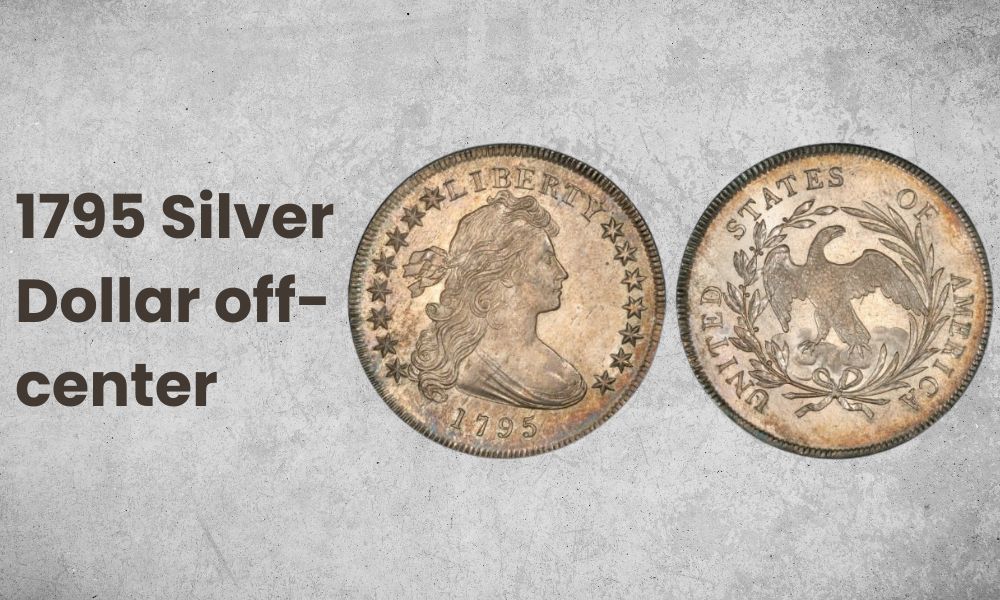
This is a very common mistake that’s found in coins minted not only centuries ago but quite recently too. As the name implies, this error happens when one side of the coin, the obverse side with Lady Liberty, in this case, gets printed slightly off-center.
Do note that this error is different from the also common nowadays misaligned error where the print is at a slight angle – with the off-center error, the print isn’t at an angle, it’s just not centered right.
1795 Silver Dollar doubled edge lettering error
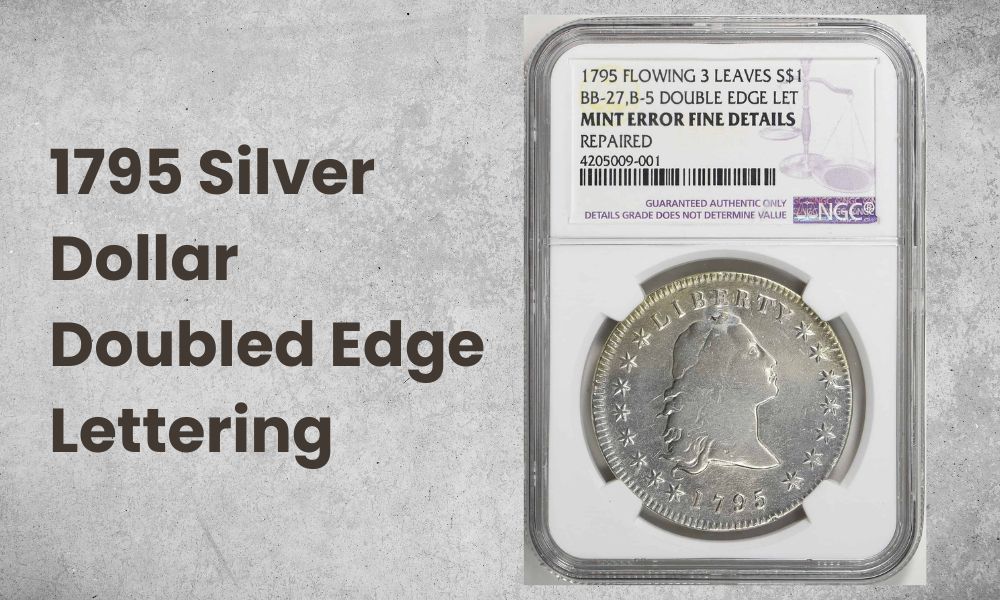
Explained succinctly, this error occurs when the coin accidentally goes through the second step of the minting process – the lettering step – twice. When that happens, the edge gets lettered twice.
1795 Silver Dollar FAQ
How can you tell if a 1795 silver dollar is real?
Given how many counterfeits there are for the Flowing Hair and Draped Bust silver dollars, it’s very important to know how to distinguish the fakes from the real coins. An expert can usually discern one from the other with a quick glimpse so you can always just go and ask a professional.
If you want to test it for yourself, however, the two simplest ways include a scale or a magnet. Real silver dollars aren’t magnetized because they are 90% silver and 10% copper. Most fakes are attracted to magnets, however, so they will almost always be attracted to a magnet.
The other method involves simply measuring the dollar – real dollars will always be ~27 grams but most fakes won’t be near that figure.
How many 1795 silver dollars exist?
It’s estimated that the US Mint has struck only 160,295 Flowing Hair silver dollars before moving onto the Draped Bust silver dollar design. OF those 160 thousands, only 3,945 exist to this day and those are accounted for in various collections. Finding a new lost Flowing Hair dollar is always possible of course but very rare and unlikely.
As for the 1795 Draped Bust silver dollar, only about 42,738 of those were made in 1795 but hundreds of thousands of other Draped Bust variants were struck later on. We’re not certain exactly how many of the 1795 Draped Busts have been found to this day but it’s unlikely to be a very high number.
Why was the Flowing Hair silver dollar changed from a design with two leaves to one with three leaves?
It’s not really clear when, why, and by whom it was decided to change the design of the Flowing Hair silver dollar from two leaves to three leaves. Presumably, it was just decided that three leaves look better than just two.
